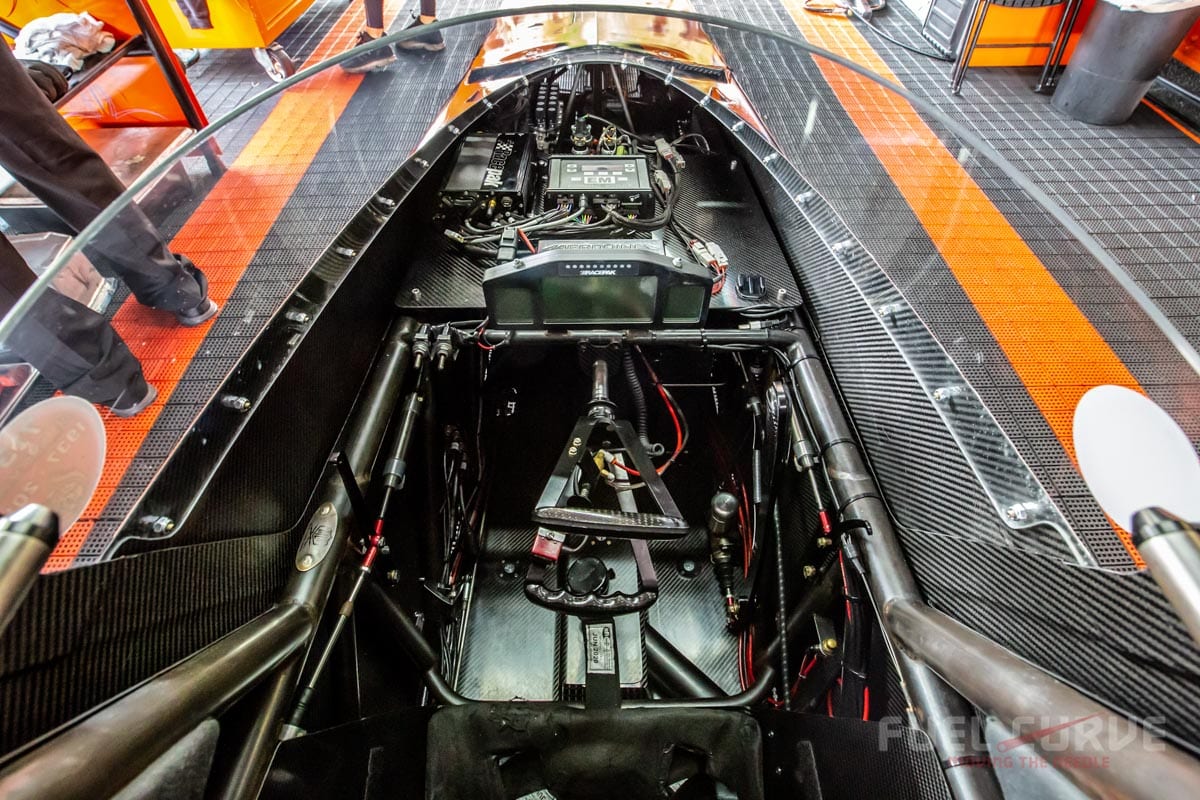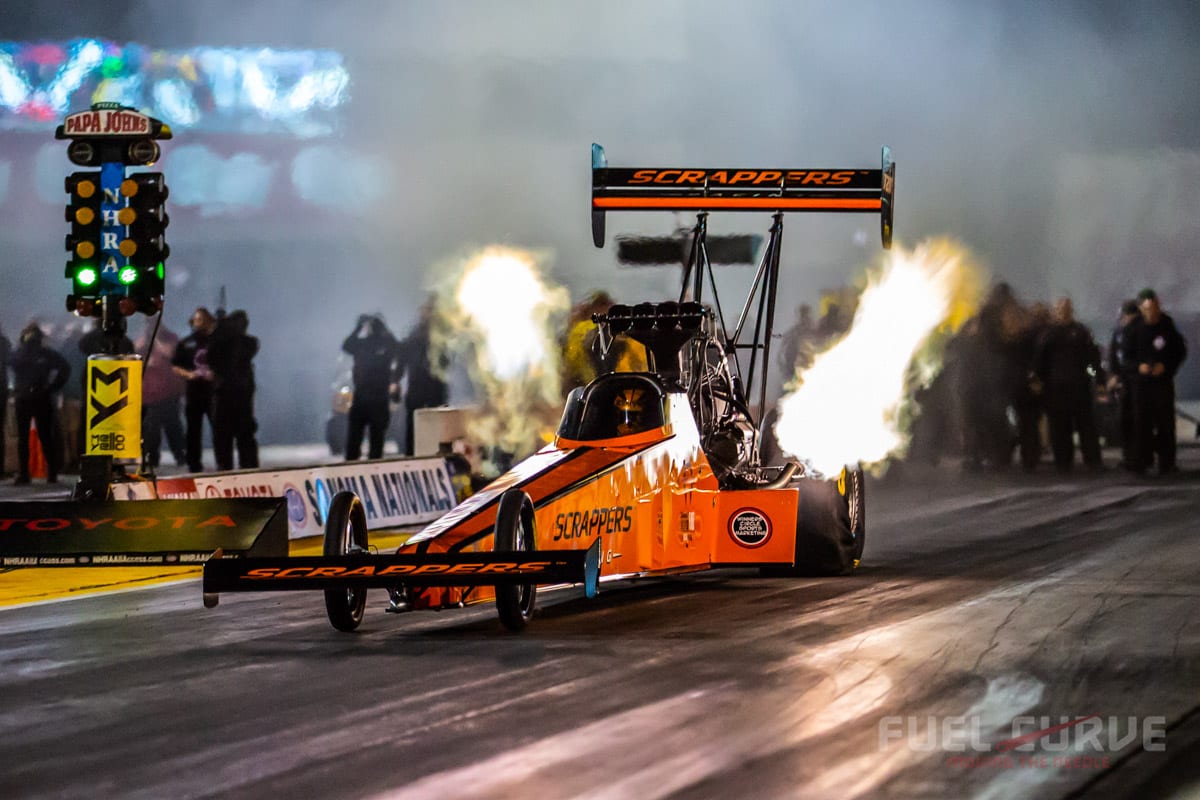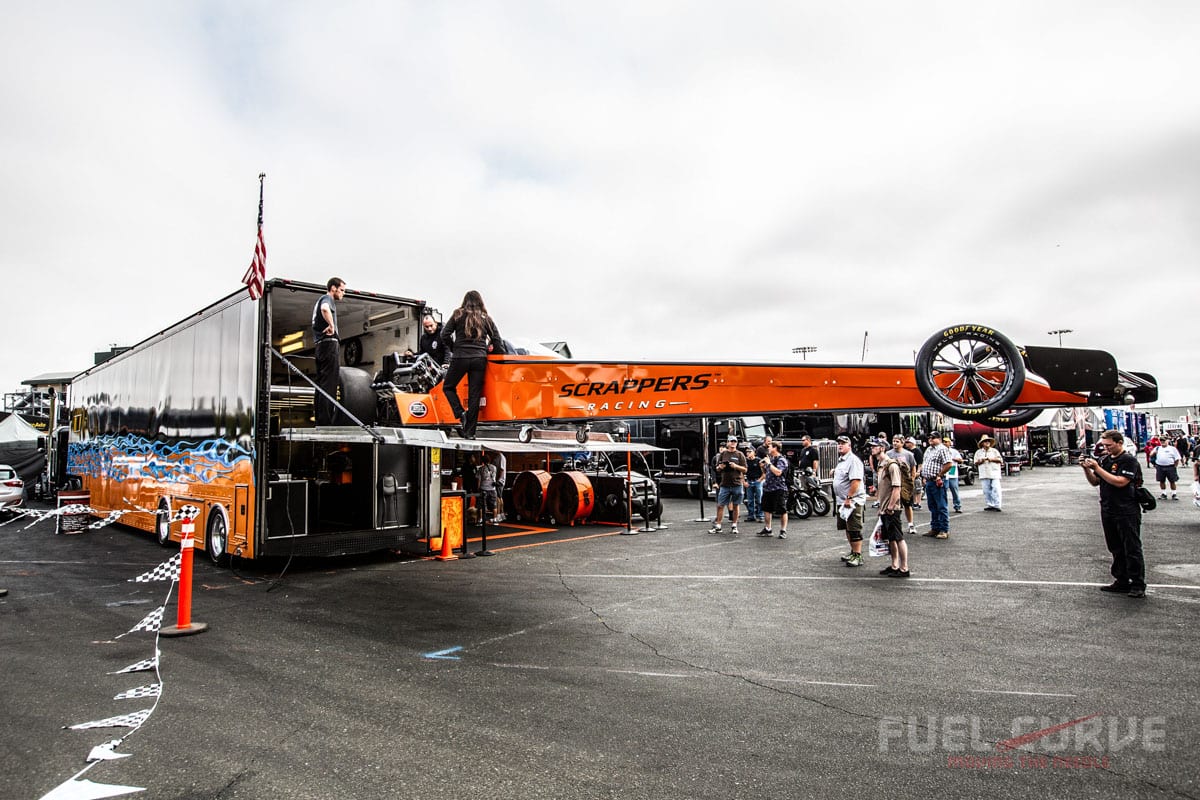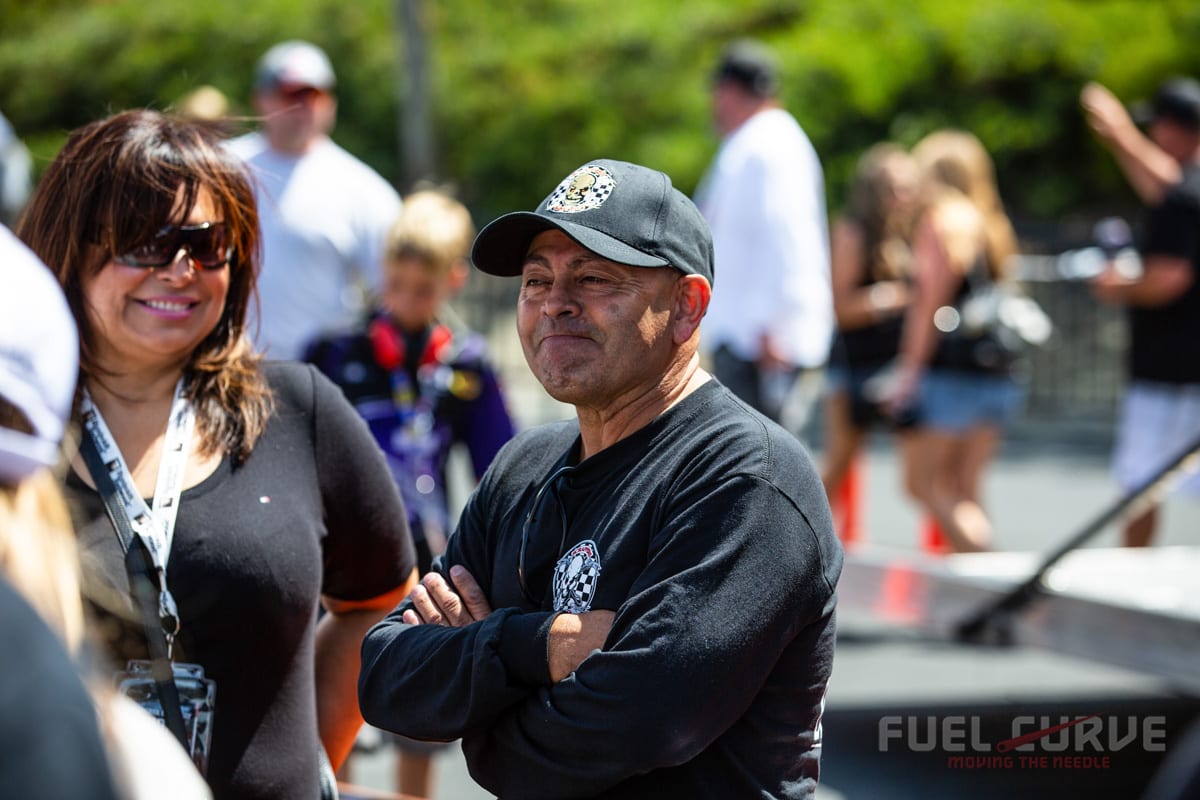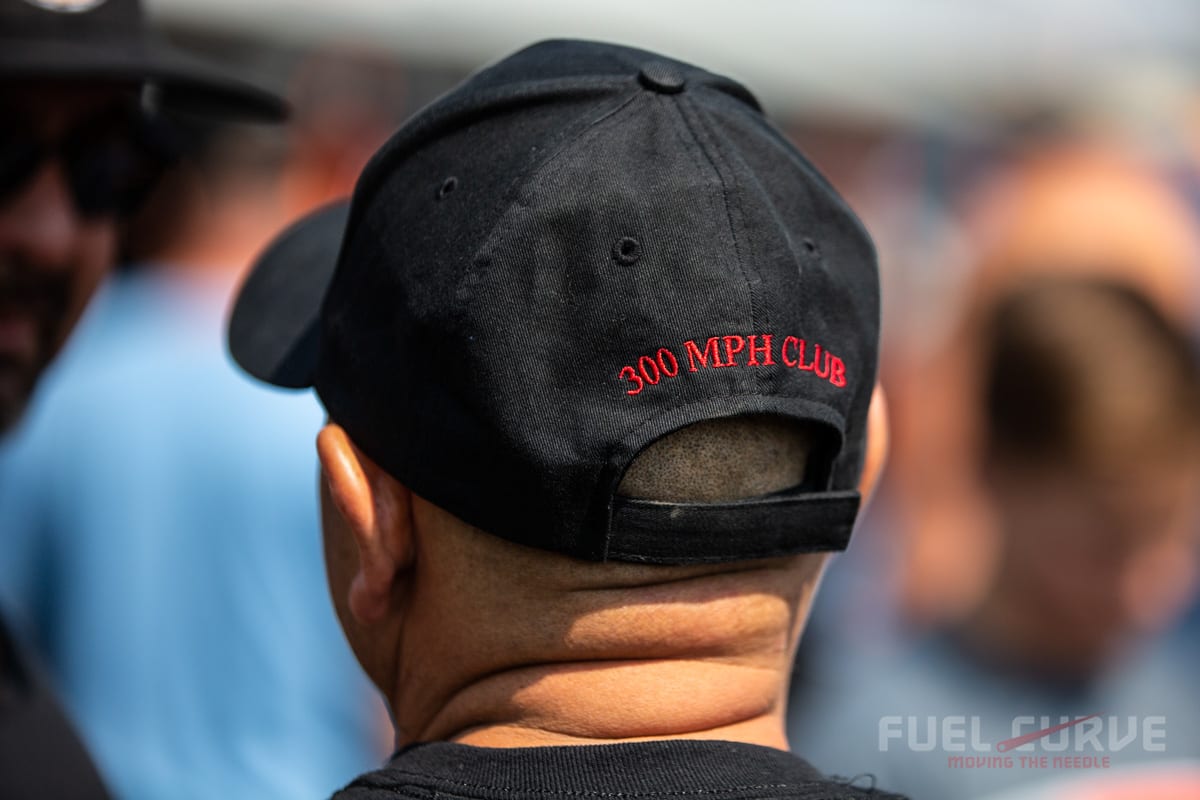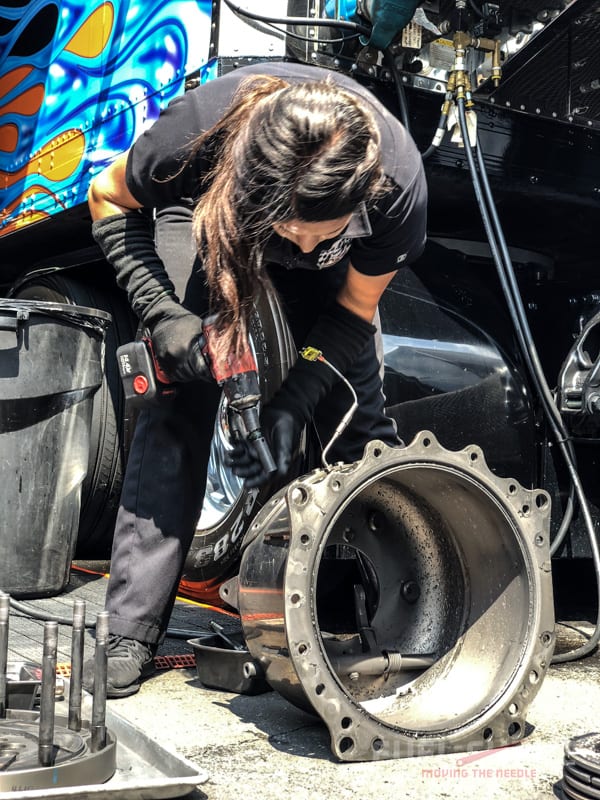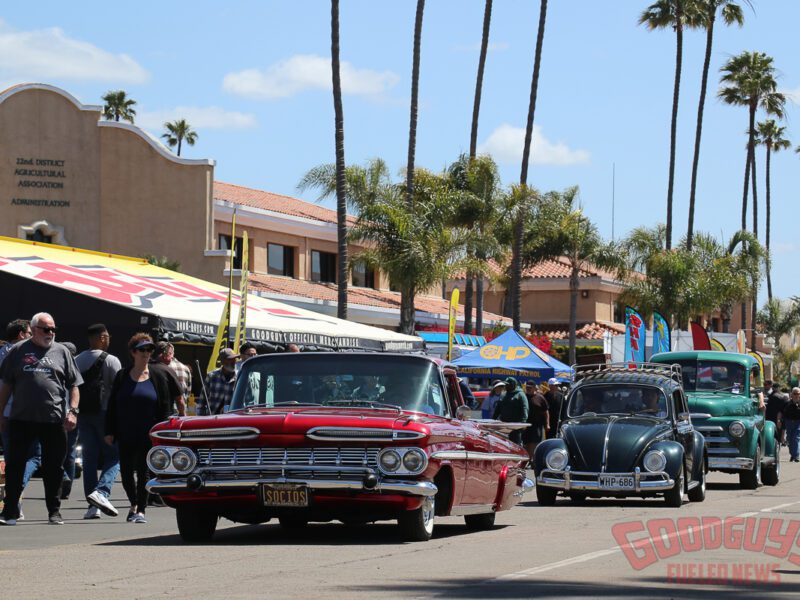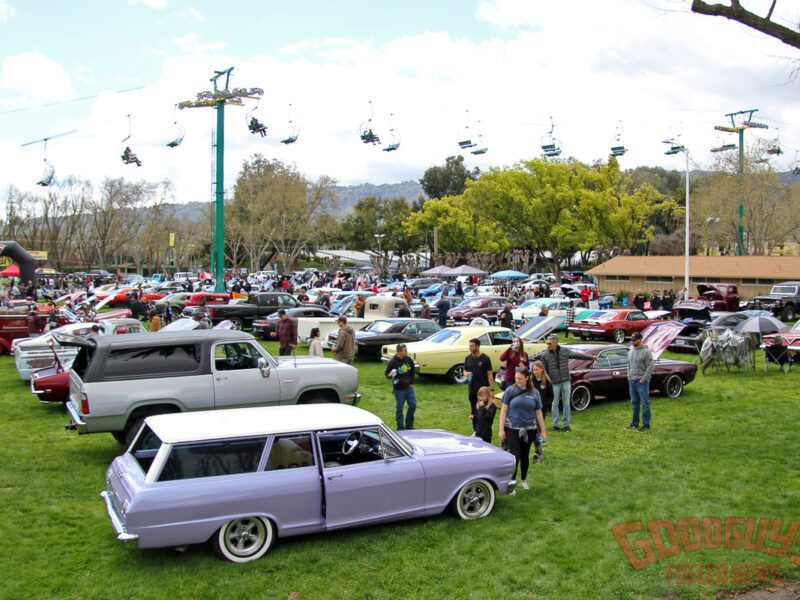Top Fuel Field Trip – A Day with Scrappers Racing
At the recent NHRA Toyota Sonoma Nationals, we had the opportunity to spend the day with Mike Salinas and his Scrappers Racing Top Fuel Dragster. A big thanks to the NHRA Communications dept for making this happen. Another big thanks goes out to Salinas and his family for allowing our photographer Jim McCarthy unlimited access to spend the day chronicling the different motions a contemporary NHRA Top Fuel team goes through during a full day of qualifying.
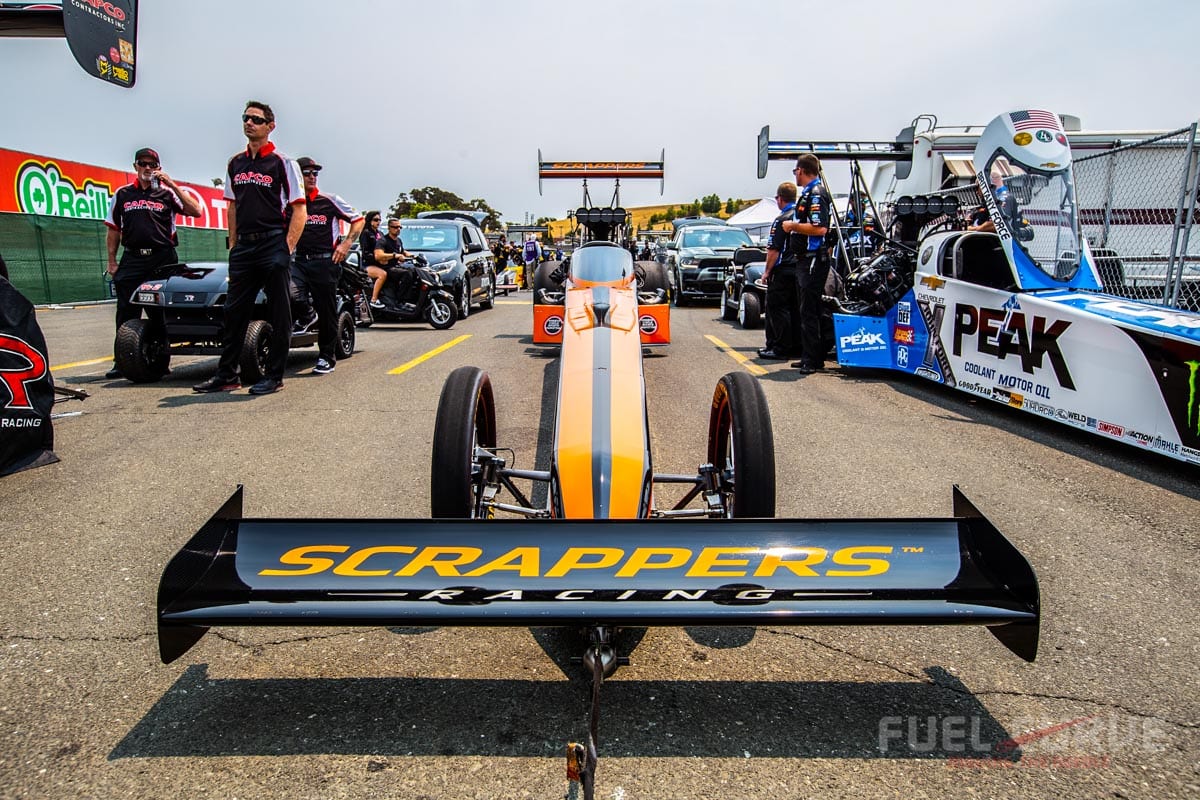
You may have heard of Mike Salinas – the San Jose, California based racer who is running the full NHRA Mellow Yellow Drag Racing Series this year. Stepping up to 24 events after a few years of running occasionally is a big commitment financially, it’s even more impressive that Scrappers Racing is basically a self-funded team. Having a recycling and equipment rental business allows Salinas to chase his dream of winning a championship against the best teams in the world.
Top Fuel Tech:
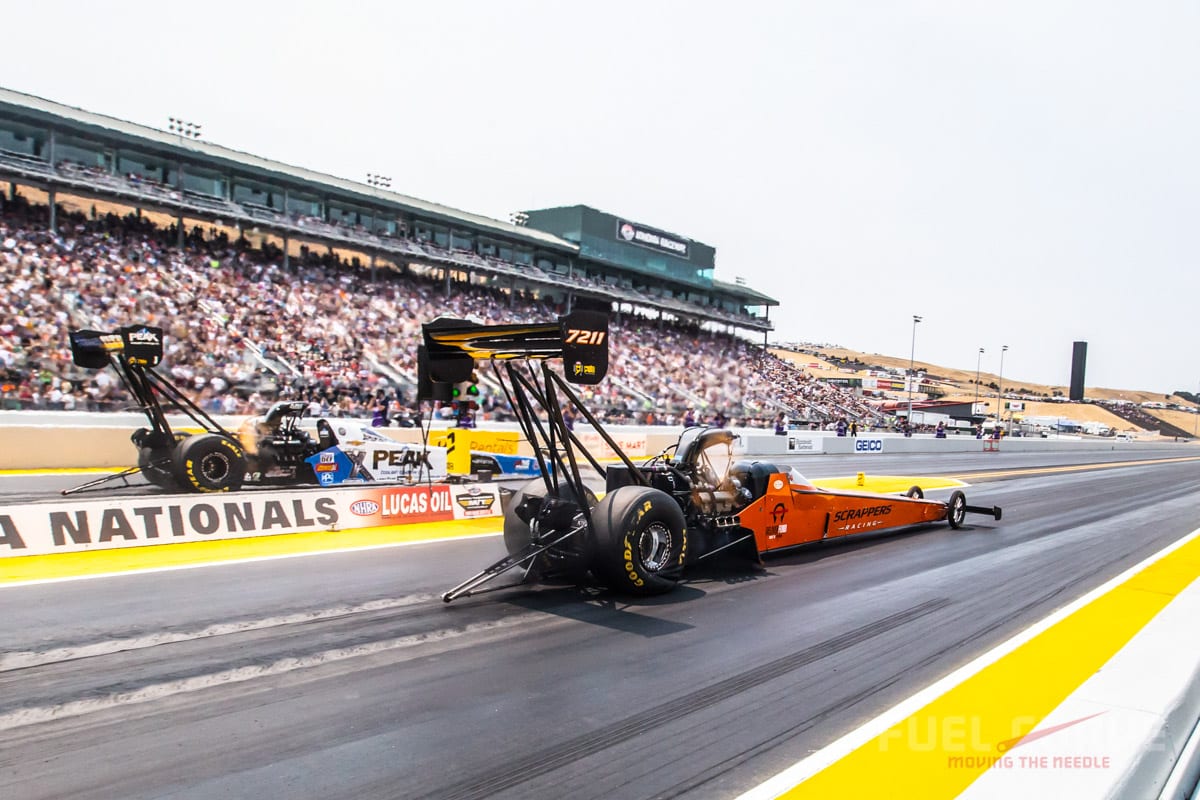
A contemporary NHRA Top Fuel dragster is a mechanical marvel. Putting out over 11,000 horsepower and over 7,000 ft lbs of torque from its giant, supercharged 500c.i. Hemi, they literally shake the earth and can be heard up to 15-miles away. They weigh just 2,300 pounds, generate in excess of 5 G’s and are capable of running 1,000 feet in 3.6 seconds at speeds eclipsing 335mph. Their massive rear wing produces somewhere in the neighborhood of 5,000lbs of downforce. Passing the finish line, the engine is spinning at 8,000 rpms. There are six to seven clutch discs inside the bell housing which miraculously transfer all that power to the 17-inch wide Goodyear slicks. Most times the tires stick, sometimes not. While nearly every team on the NHRA circuit can make the necessary horsepower, the magic to making these beasts run consistently lies within the clutch can. If you can finesse that, you can haul ass and take names.
Starting the Day:
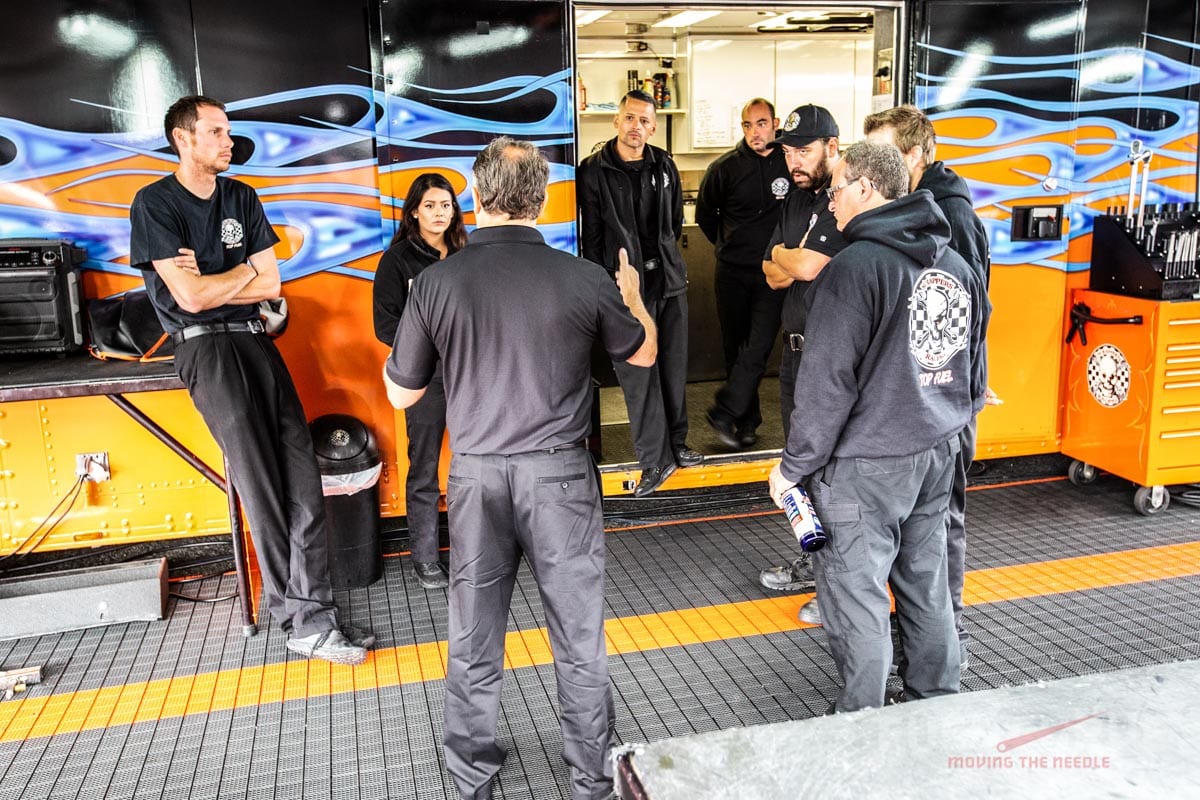
The Scrappers Racing Team arrives to the track before 8am for a national event. The first order of business is to unload the dragster from the massive semi-truck and trailer. For ease of motion, the 300-inch (33.5 feet) dragster is rolled in and out of the box with a special rolling dolly the team fabricated, making it pretty easy to move around. No more than two crew members are needed to get the car out of the box.
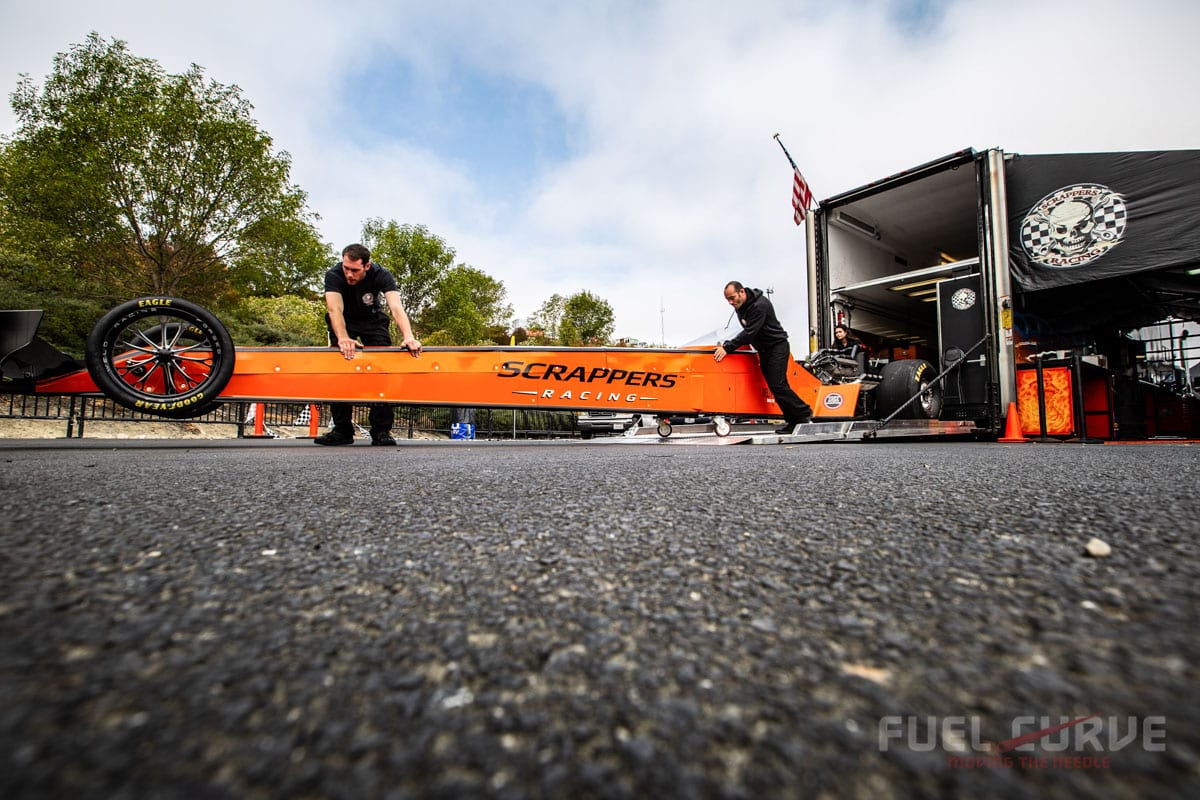
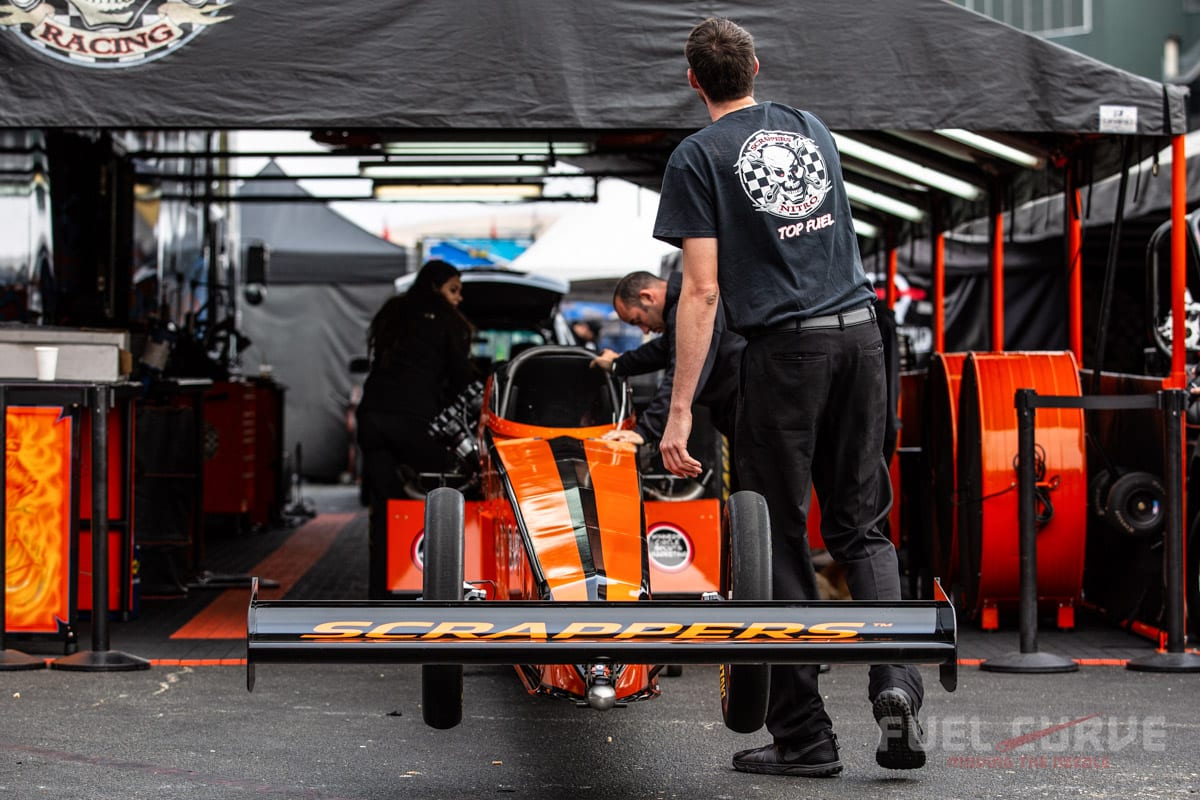
After its rolled into its pit side position, the crew begins their mechanical rounds. But before that process begins, the crew huddles to recap the last event, what went right, what needs improvement, the plan and schedule for the current day’s activities, what specifics need to be addressed, as well as any changes the crew needs to be aware of. Motivation and positive vibes are big with Scrappers Racing. Crew chief Doug Kuch offers encouragement and strategy. While the team is getting the car dialed in, Mike is spending time with family getting his head right. He shuts off his cell phone so he can focus 100% of his attention on the task at hand. There are no business discussions allowed unless its racing related.
Preparation:
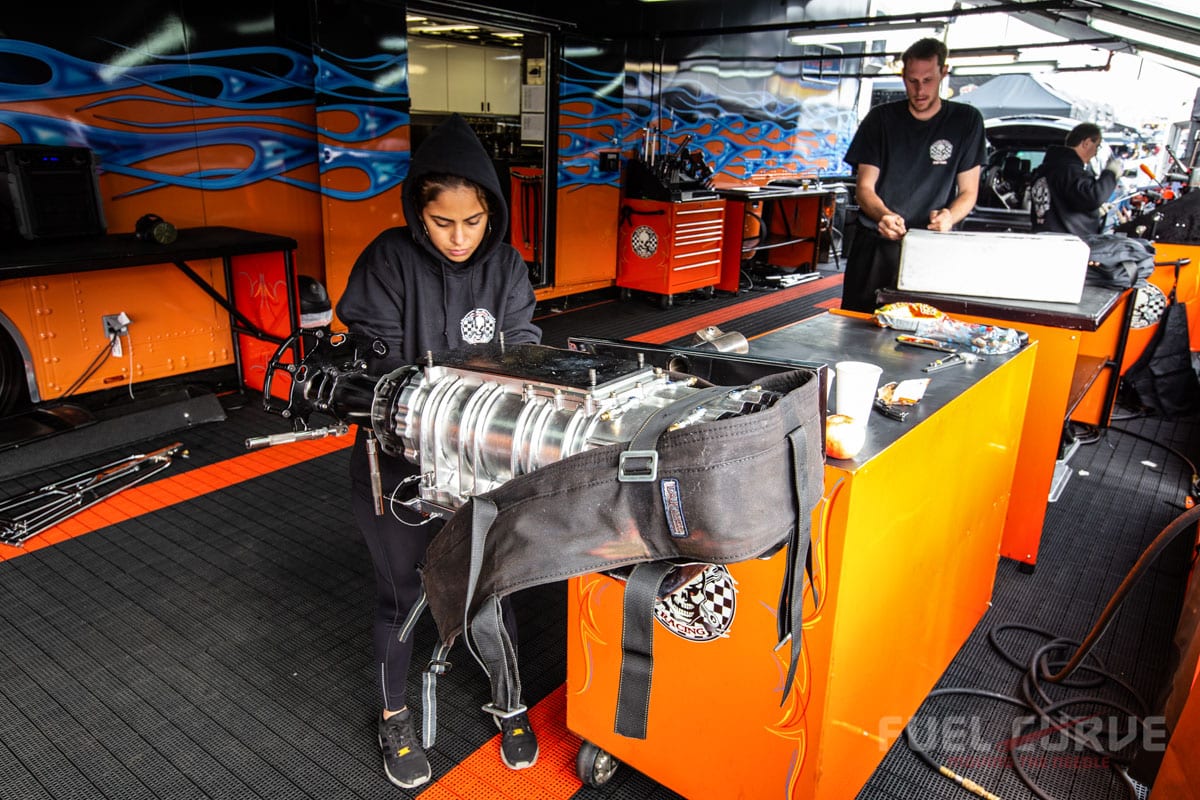
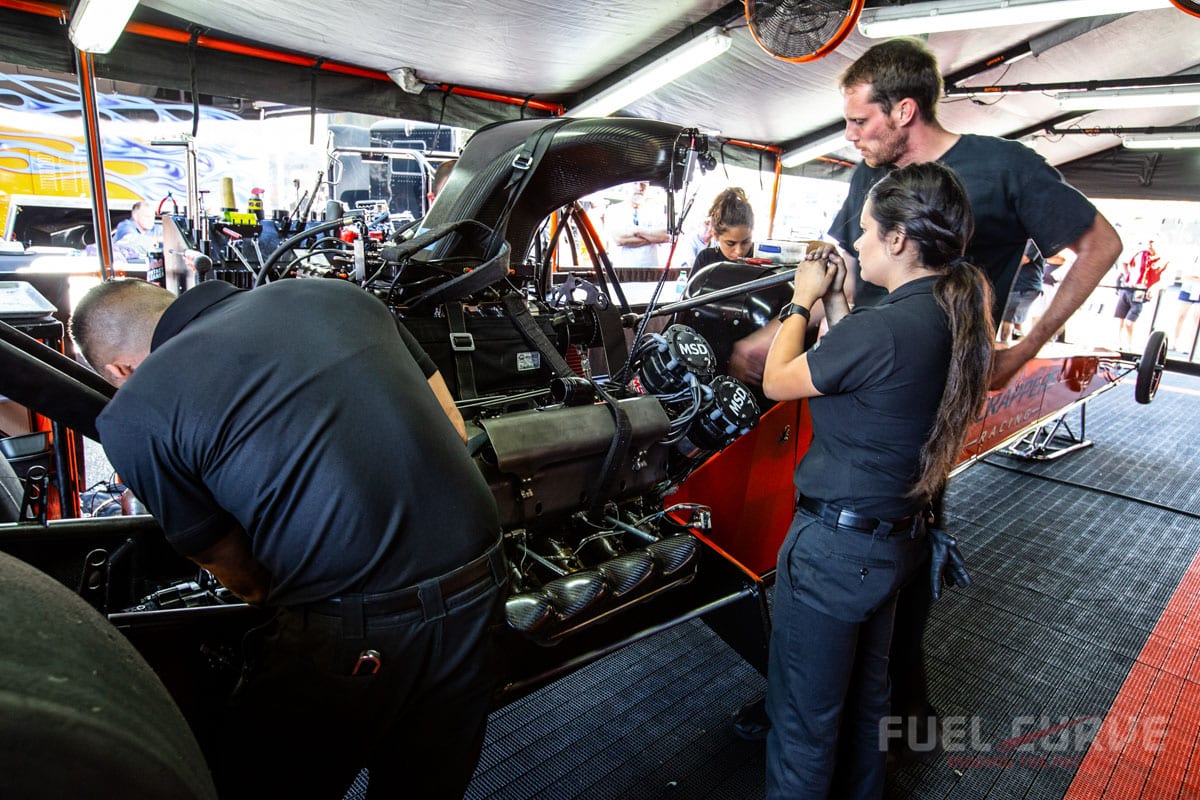
As the morning progresses, the crew gets busy working on their specific area of the car. Mike’s daughter, Jasmine, is the team’s “floater” and supercharger assistant. By day she’s an executive assistant in the big, fancy city of San Francisco but when the races start she gets her fingers dirty and does whatever it takes to win.
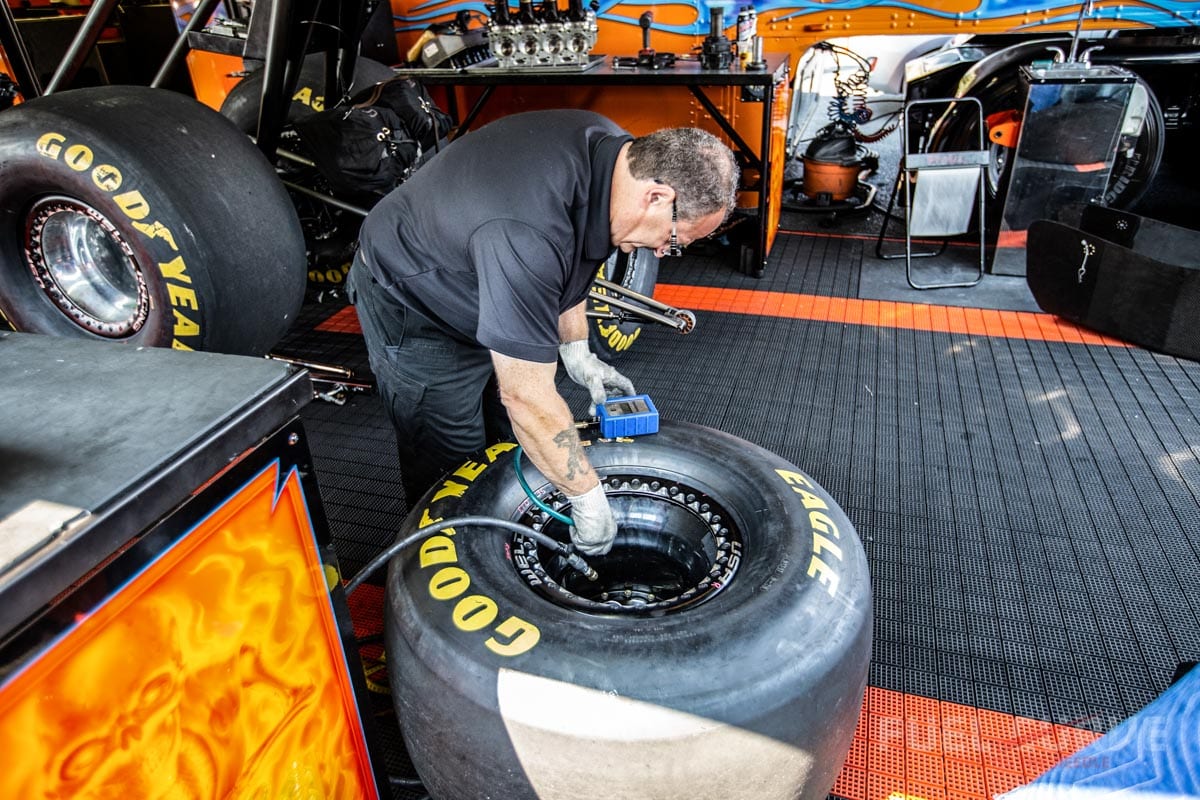
Team members like Joe Lamatrice checks the tire pressure which changes regularly based on atmospheric conditions as well as the track surface. The ideal tire pressure for an average top fuel run is 6psi. Most teams prefer the tires to be almost flat at the starting line so when the car takes off the tires can expand out and get a bigger footprint offering more grip for the launch.
Hospitality:
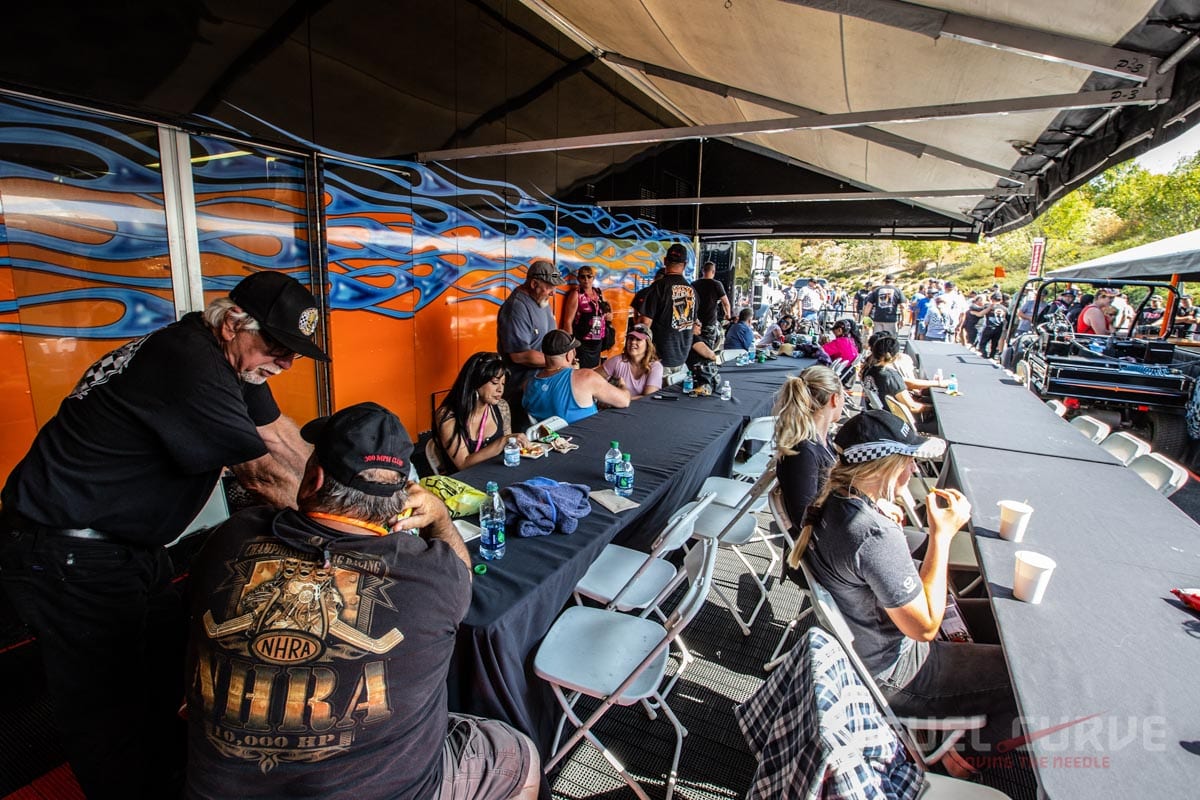
Not only does the team use their giant semi for transporting the car and the necessary equipment, another full semi rig transports hospitality supplies as well as spare engines, tools etc. The team sets up the rigs opposite each other creating a spectacular environment. The daily guests range from sponsors, friends and family and even some lucky fans.
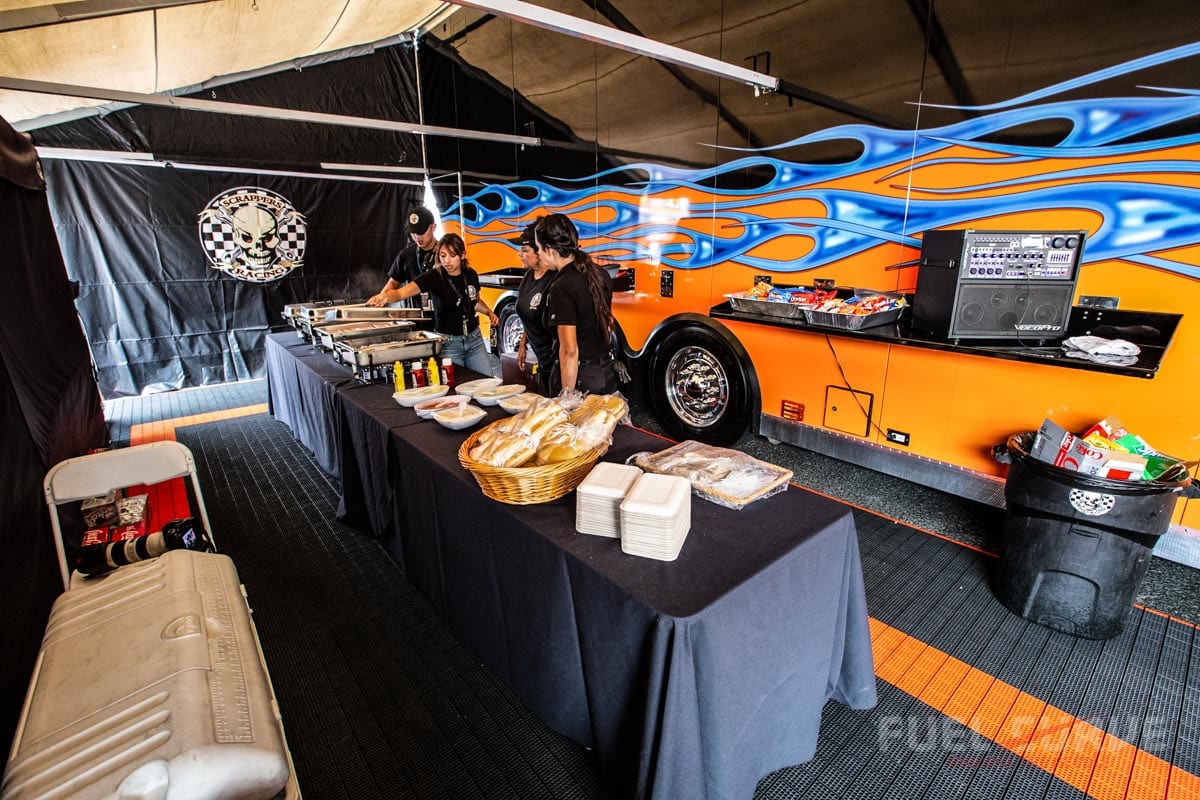
Jasmine Salinas explained the team’s philosophy when it comes to taking care of those who help and support them. “We’ve met so many great fans this year. We regularly invite them in so they can come rest their feet and sit down. We have met so many amazing people from around the country by opening up our pit area to them. That’s a big reason why we do this. We want to share the experience with others. We are a new team with a new perspective and doing things our own way which is refreshing. We want to give the fans something new and different and I think we have been successful at that,” she said.

The Salinas family does the cooking and hosting but sometimes they cater in food and beverages based on the size of the event. Spec Miata racer Hannah Grisham was one of the guests during the Sonoma weekend and as you can see, was clearly enjoying the experience!

Getting Ready for the Run:
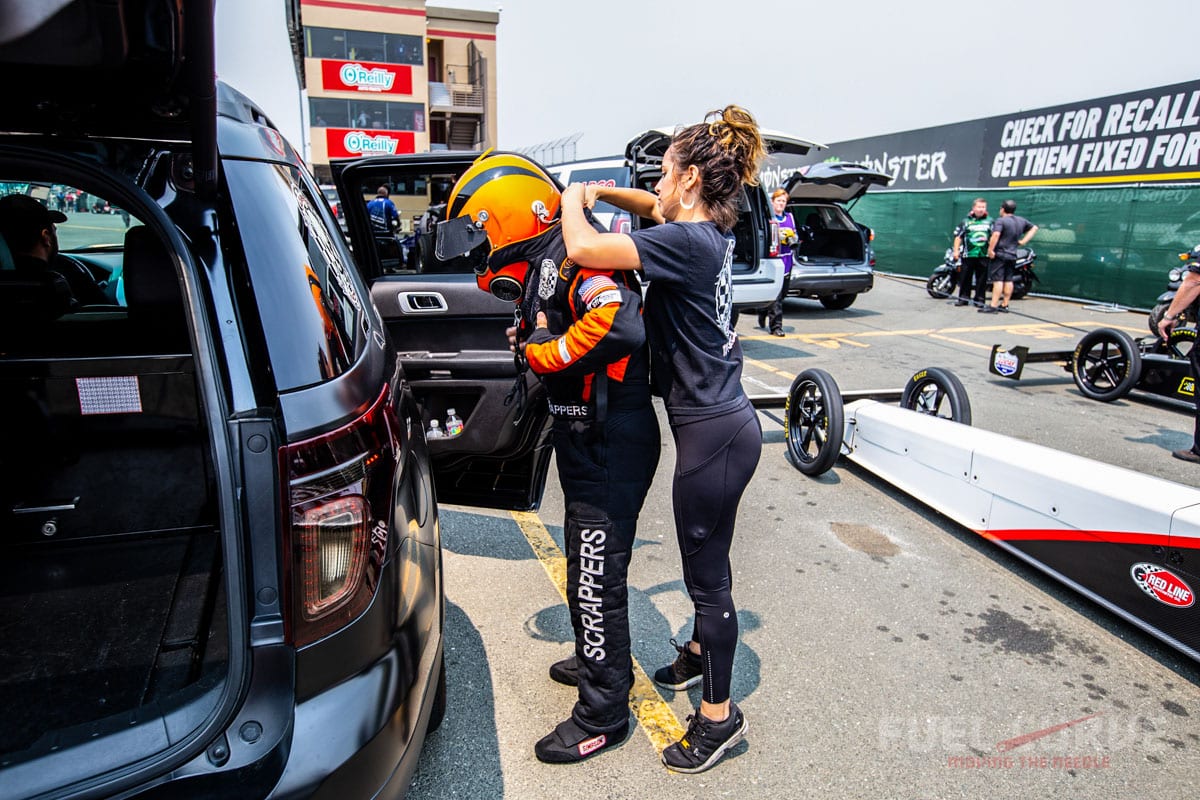
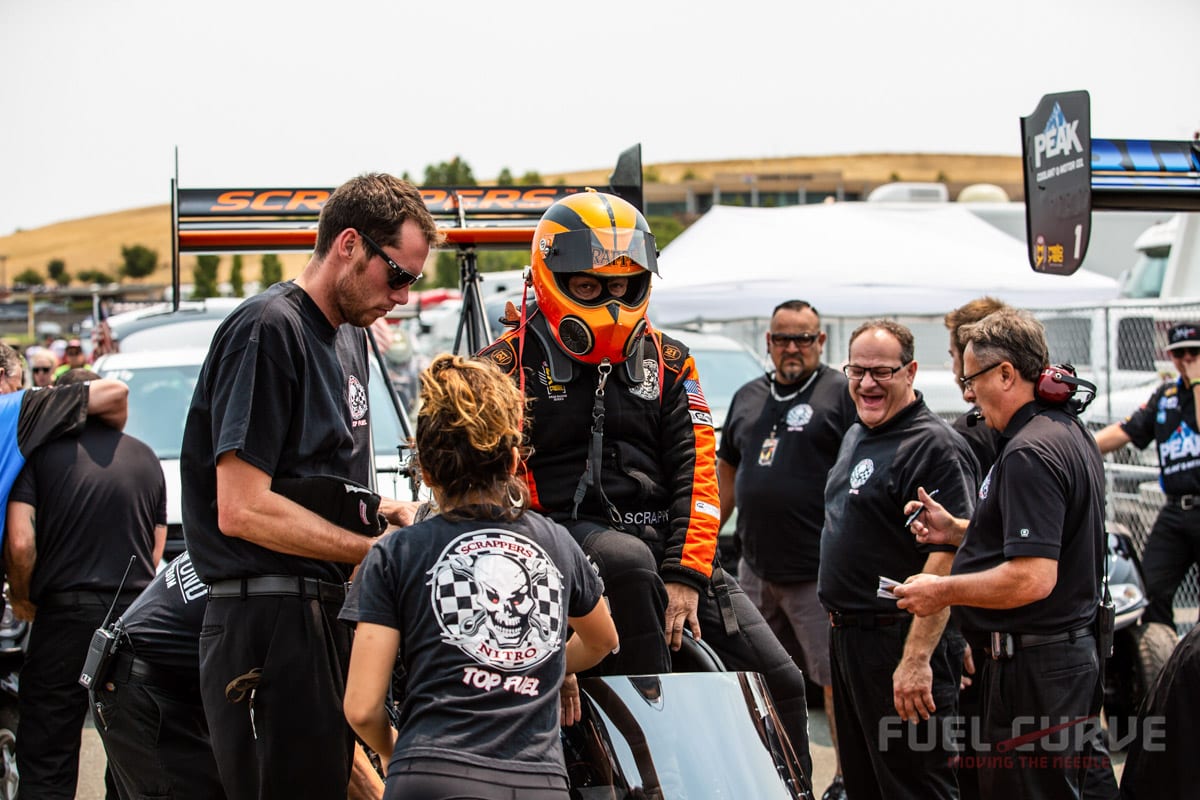
The hydration tip was first suggested by Chris Karamesines’ granddaughter and fellow racer Krista Baldwin.
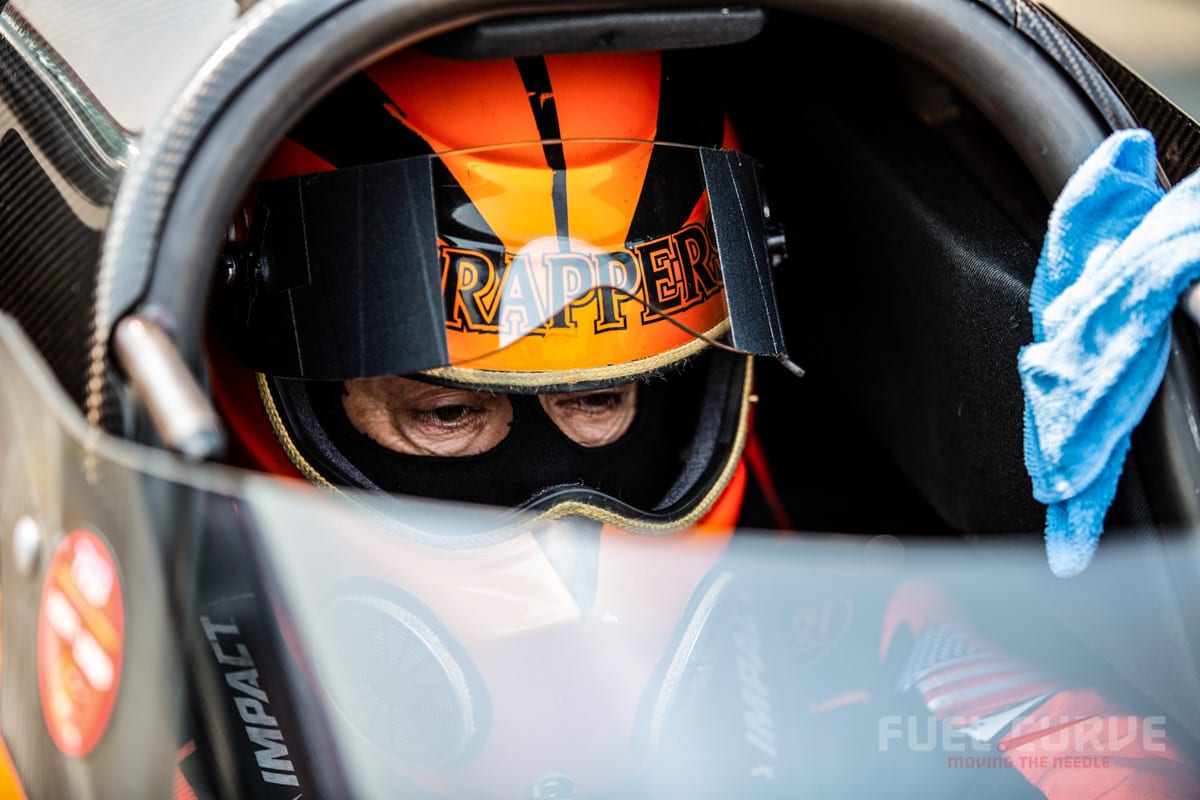
Jasmine added “Once the call goes out to get suited up, we get in the zone and can’t have any distractions. The team has a rule to ‘not bother or distract’ Mike so he can get laser focused. He’s good at blocking everything out. He blocks out the fans, the track equipment – anything in his vision is erased and he focuses solely on the dragstrip ahead. Mike uses the SFI mandated fire suit, a HANS Device, Radio communication equipment, along with Simpson safety gloves and boots. Once strapped in, the crew pushes the dragster to the water box and gets ready to light it off.
The Run:

The car does a smallish burnout then reverses gear cackling loudly back to the line. The entire process from startup to launch to shut down takes just under two minutes. It’s a very methodical process which the team has refined. At the Toyota Sonoma Nationals, Mike ran a best time of 3.823 @ 322.34mph in qualifying. Breaking that run down with the NHRA-supplied data and incremental times, you can get a decent idea of what the car is doing as it speeds down track. On the 3.82 lap Mike cut a .120 light (bad by his standards) and recorded a 60 foot time of .834 seconds. Moving along, the Scrappers Racing Top Fuel Dragster ran 2.160 seconds to the 330 foot mark and made it to halftrack in 3.070 seconds at a speed of 280.72 mph. That all happened in just 660 feet! We doubt even the space shuttle folks enjoy that kind of brutal acceleration.
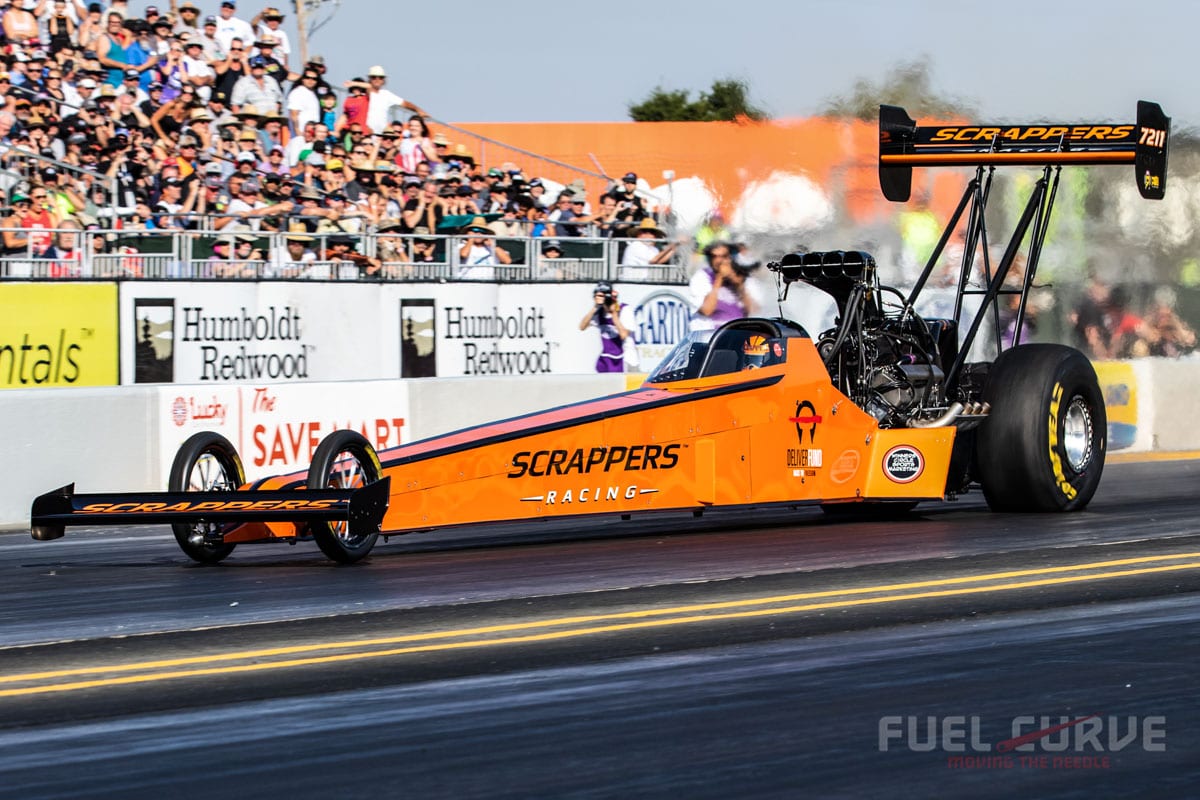
The Teardown:
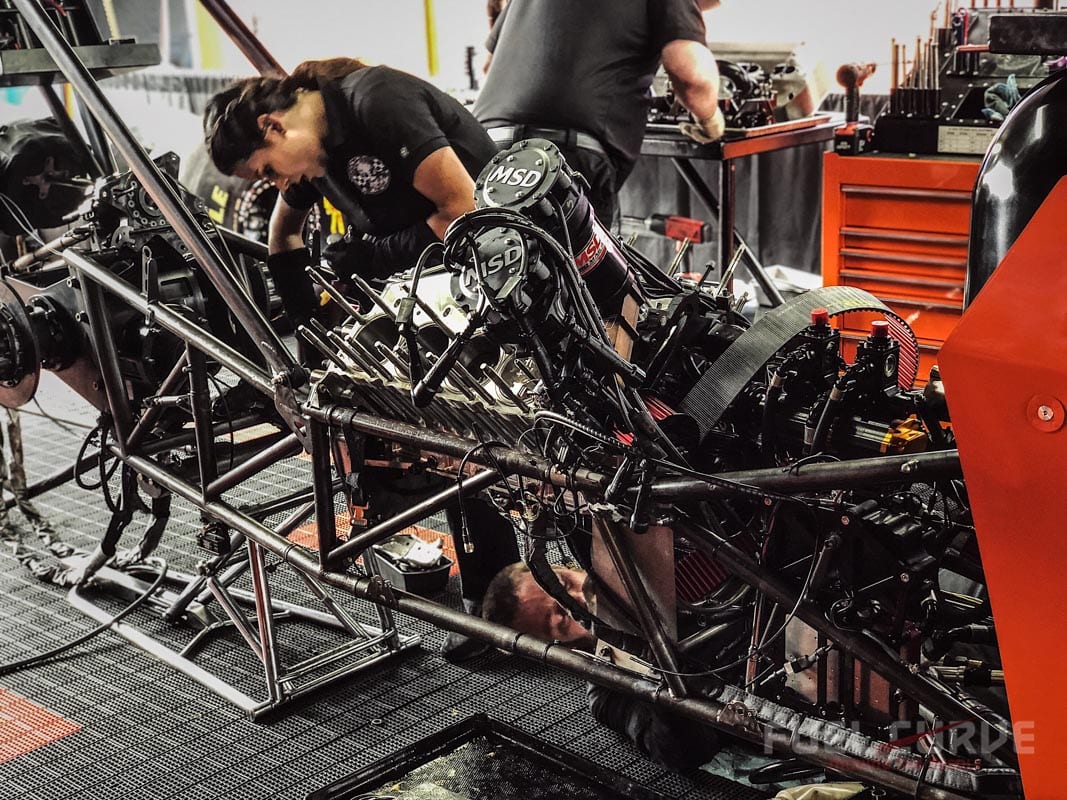
The Carnage:
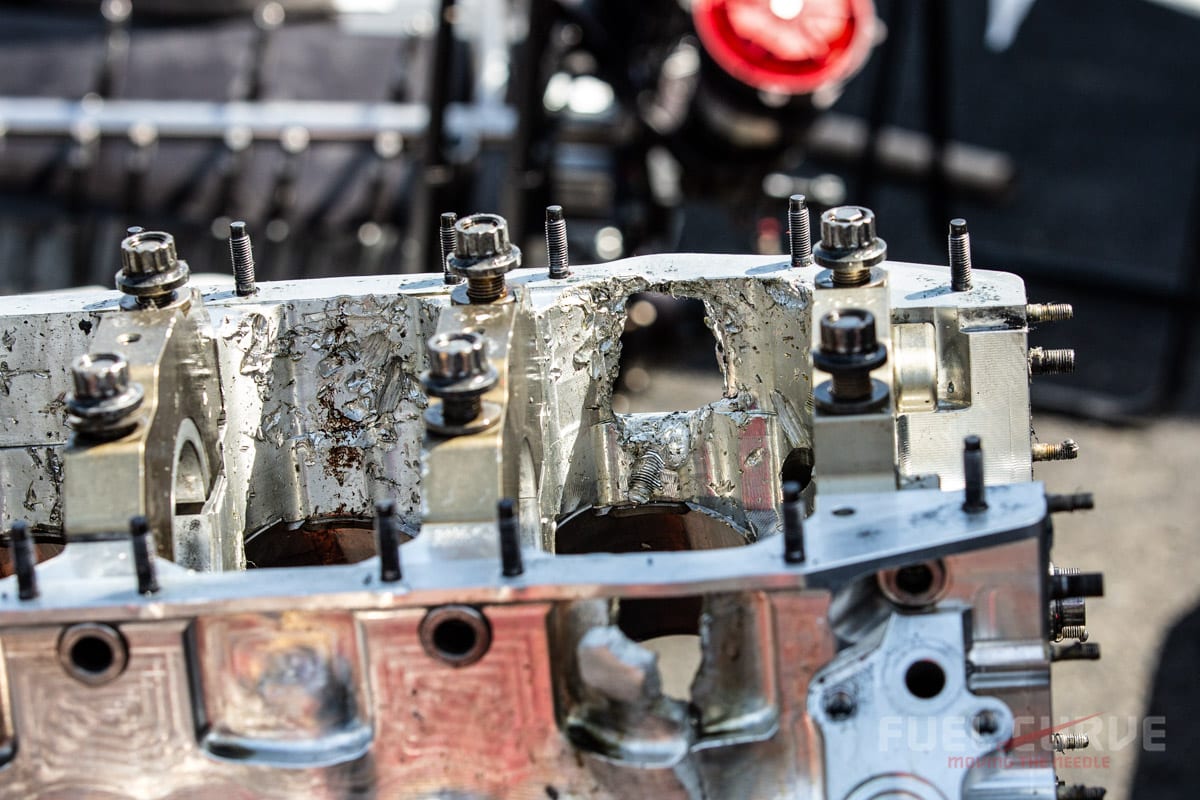
When you compress nitro methane it’s basically like trying to contain and finesse a nuclear explosion. Being the engines are made entirely of aluminum, parts fail routinely. As you can see by the images here, Mike ran into trouble on his initial pass. They broke a connecting rod (very common) and it put the bottom of the rod right through the oil pan. Broken cranks, exploded superchargers and “windowed” engine blocks happen more than the teams would like, but it’s just part of the deal when you slap a Top Fuel sticker on your dragster.

The Team:
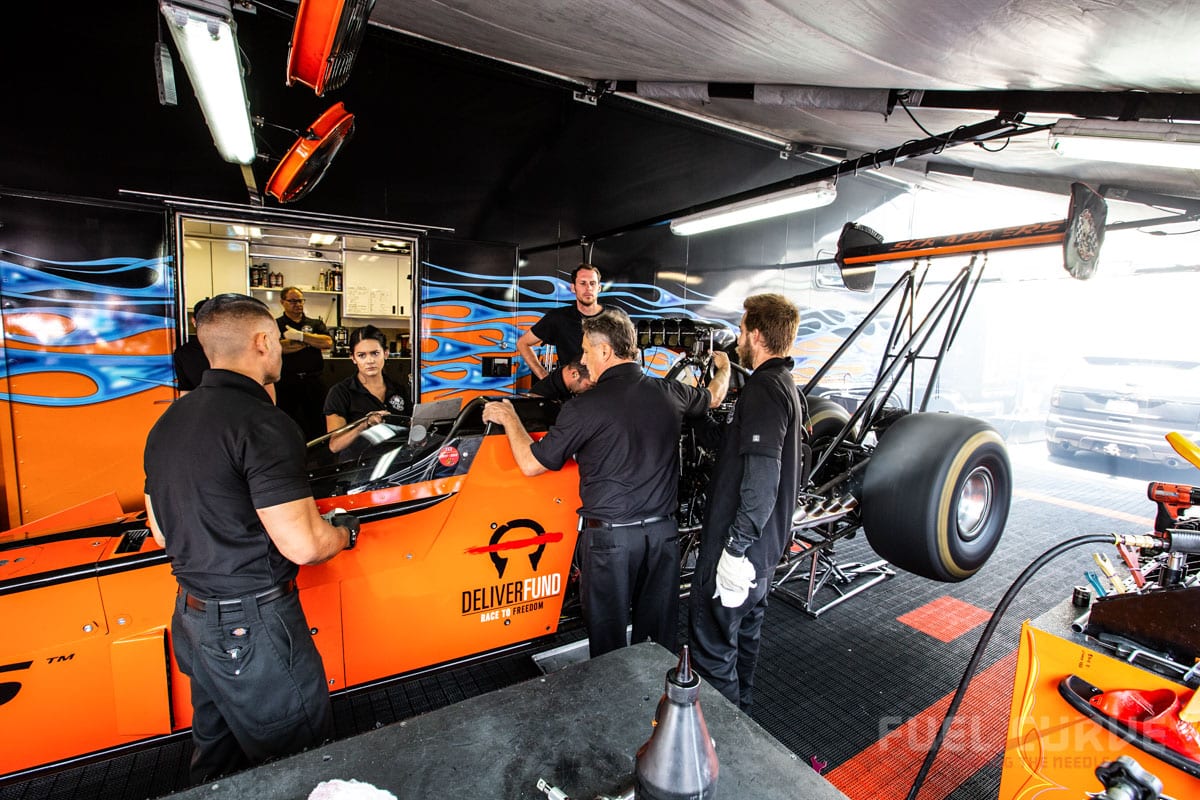
That cute little Pomeranian you see is “Stevie.” He was attending his first race and did good – he enjoyed meeting all the people. The Scrappers Racing Team is a full on family affair. Mike’s wife Monica joins him as much as possible. She is currently finishing her college degree, so the transporter’s lounge comes in quite handy for homework. Their daughter’s Jasmine (currently racing Top Alcohol), Jacquelin, Jianna (who is currently training to ride a Pro stock motorcycle) and youngest daughter Janae are regulars at the races.
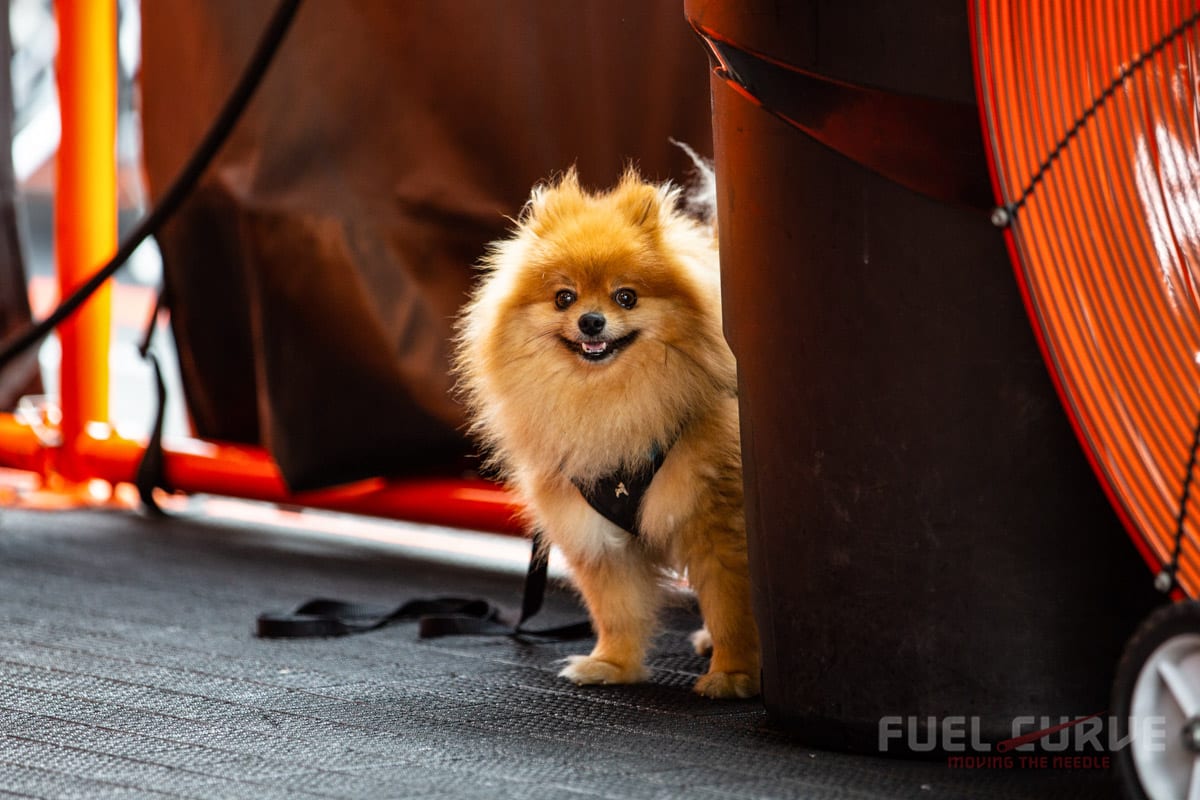
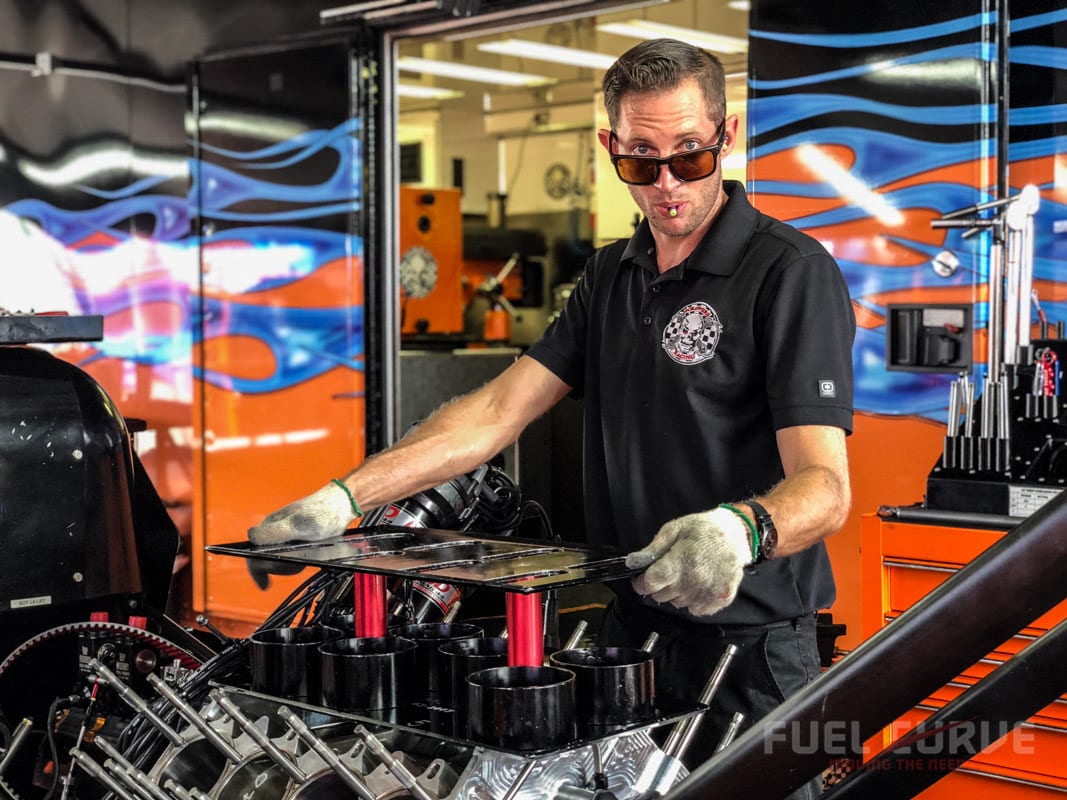
Crew Chief Doug Kuch calls the shots for Scrappers Racing but he collaborates on additional tuning help with World Champion crew chief Alan Johnson who is a team consultant.
Team manager Mono Jimenez and his daughter, Alyssa, are responsible for not only race day duties but keeping the operation running down the road. Together they handle travel and flight bookings, lodging for the crew, credentials and more. On race day, Mono does the clutch while Alyssa works on the motor. Other crew members (Adem Cave-Cylinder Head Specialist, Bob Knudsen-Supercharger Specialist, Matthew Thompson-Bottom End Specialist, Andrew Waits-Short Block Specialist and Greg Samspon- Hauler Transporter) round out the squad.

Out of necessity, the team recently relocated from California to Brownsburg, Indiana to minimize travel costs. Towing to every race from the San Francisco Bay Area just isn’t possible.
The Goal:
The goal of any race team is to win a championship. Mike Salinas and the Scrappers Racing team have that vision while approaching their effort with a methodical and reasonable approach. Once their first full year on tour is under their belt, they will use that experience and data to become perennial challengers. While they are fiscally conservative, they run as hard as the other teams.
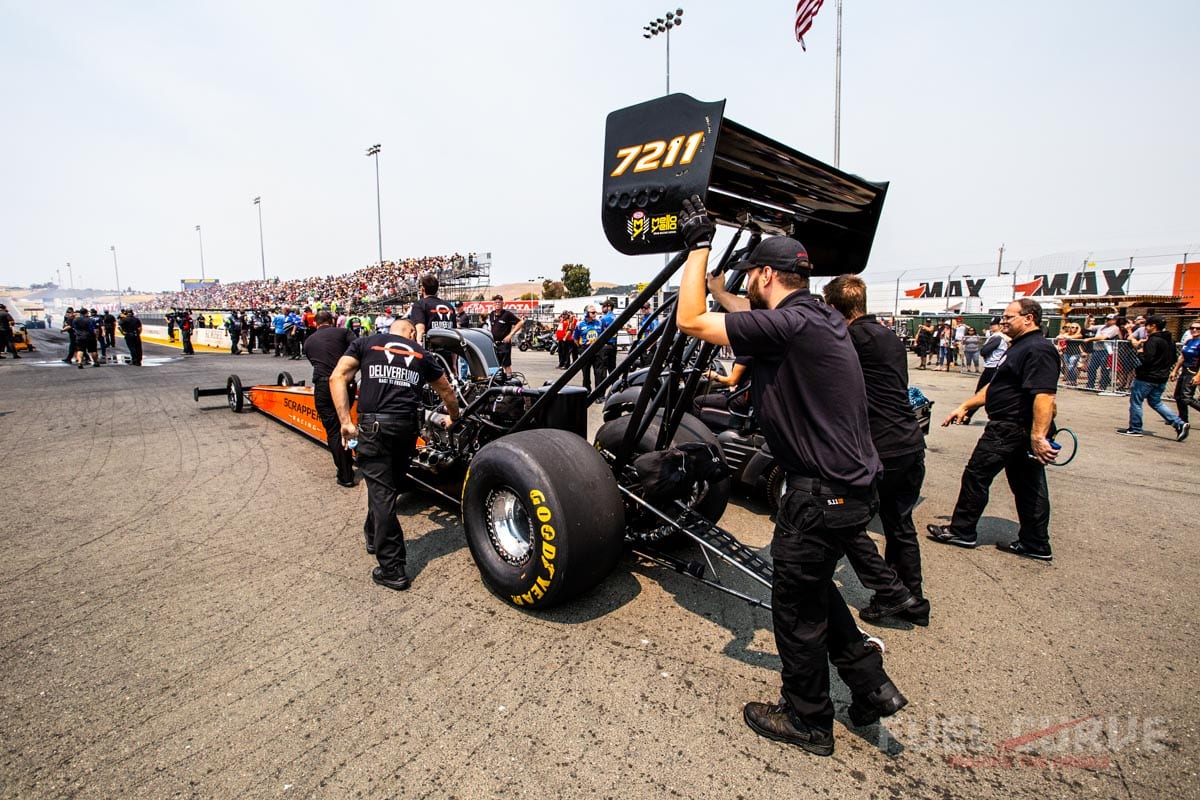
Currently, Mike sits 10th in NHRA Mellow Yellow Championship points. If he stays in the Top 10 after the Chevrolet Performance US Nationals over Labor Day weekend he will have just a good a chance at the 2018 Top Fuel title as the other nine drivers. The NHRA resets the series points after Indy so it’s a level playing field heading down the stretch.
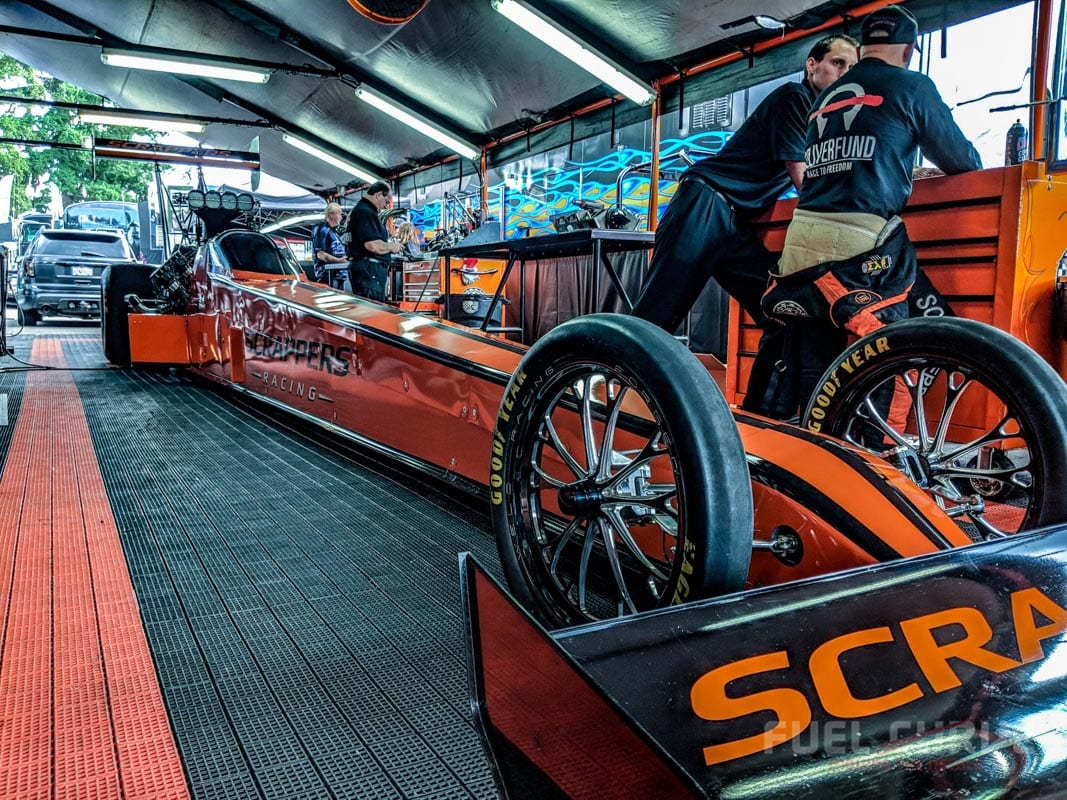
After getting to know the Scrappers Racing Team and hanging out with them in Sonoma, we can’t help but root for them. They are professional, talented and have one of the best looking dragsters in NHRA Top Fuel competition. They’re a first class operation gaining momentum in a very tough game. If you find yourself at an NHRA National Event this season, you might just end up sitting in their pits watching this spectacle with a front row seat.
